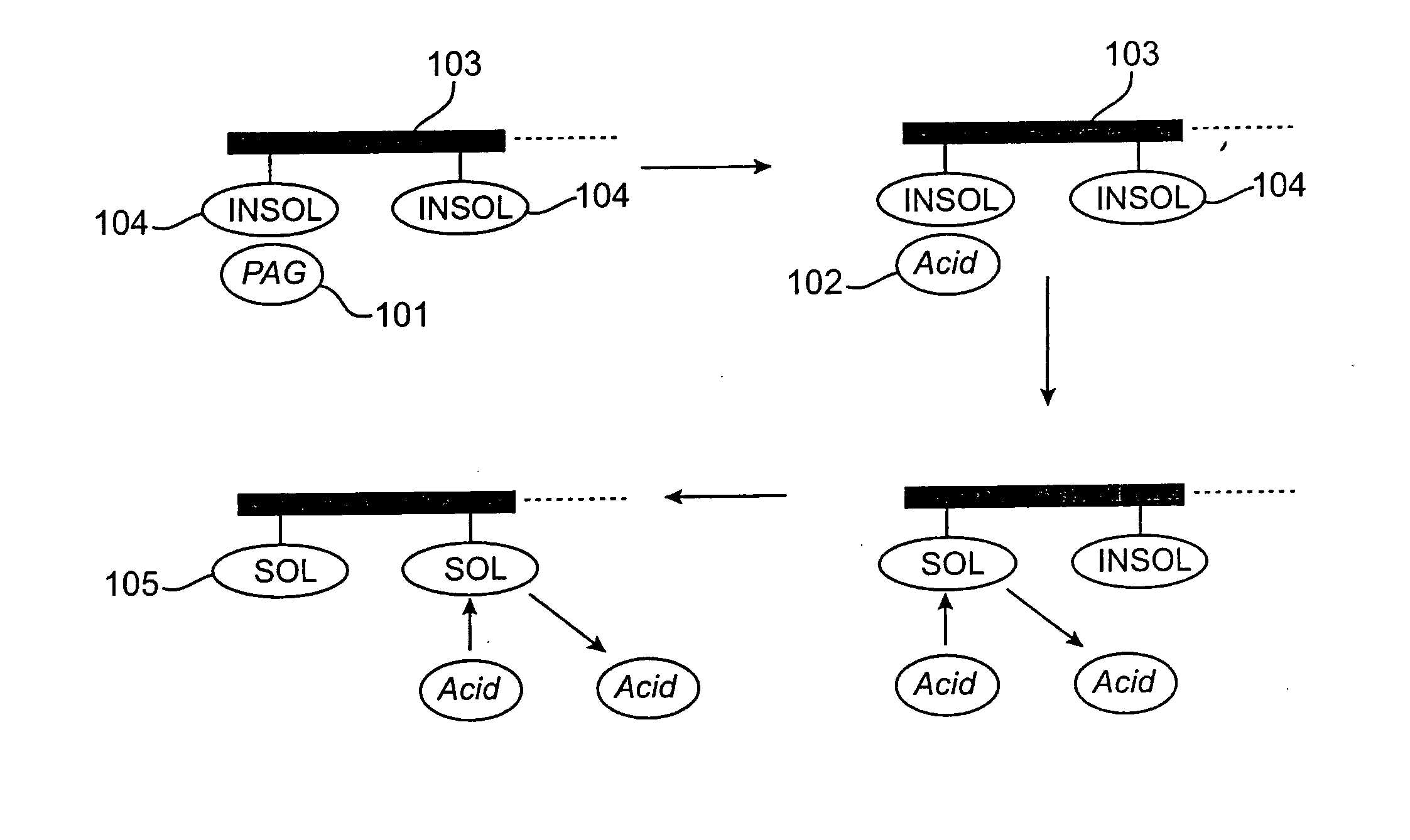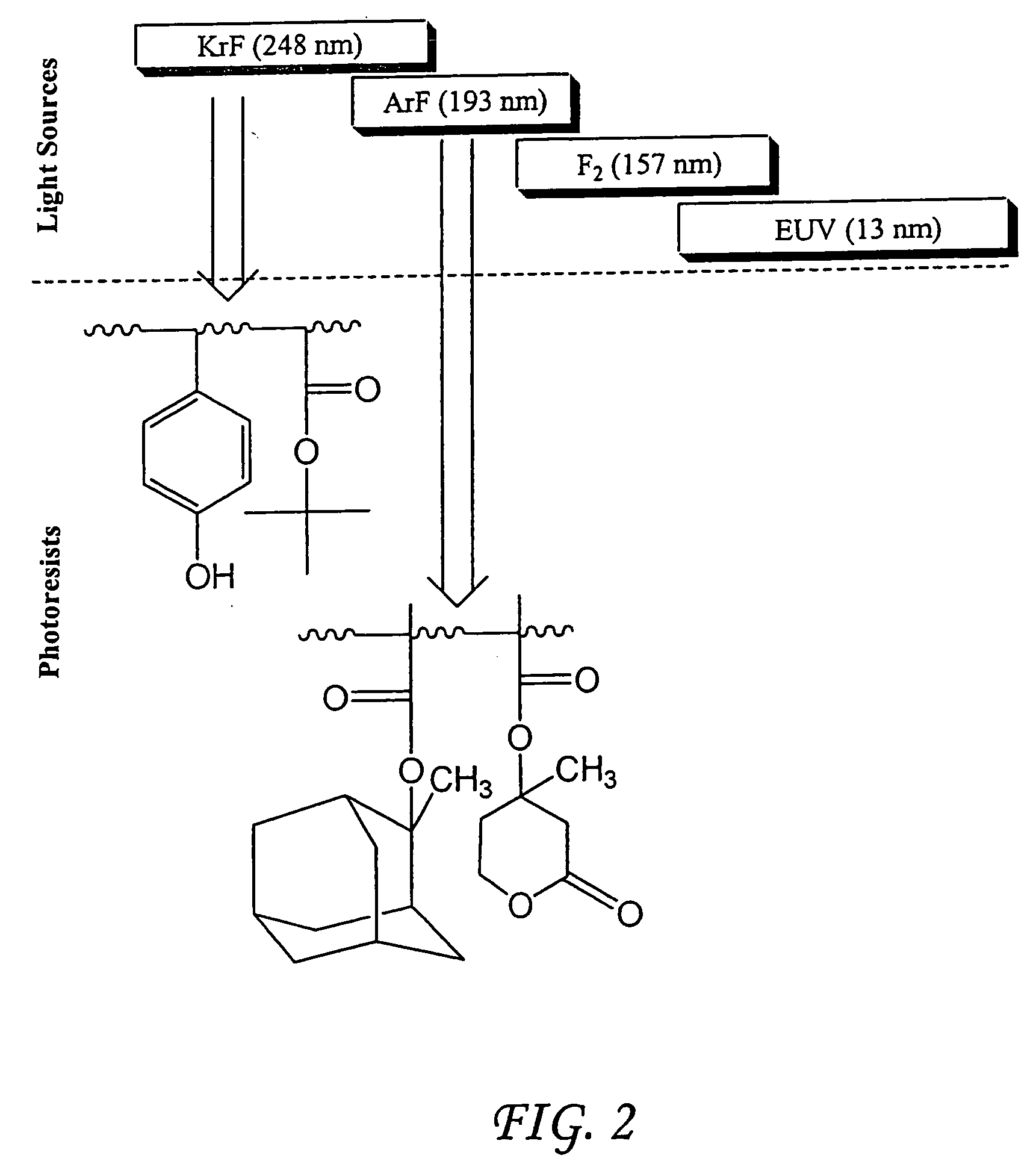Photoresist compositions comprising diamondoid derivatives
a diamondoid derivative and composition technology, applied in the direction of auxillary/base layers of photosensitive materials, instruments, photosensitive materials, etc., can solve the problems of different solubility of the developer for the exposed and unexposed regions of the resist layer, and the inability to use phenolic based resists in these shorter wavelength regimes
- Summary
- Abstract
- Description
- Claims
- Application Information
AI Technical Summary
Benefits of technology
Problems solved by technology
Method used
Image
Examples
example 1
47.1 g of diamantane was dissolved in 375 ml of acetic acid, then 4.1 g of N-hydroxyphthalimide (NHPI), 0.322 g of Co(acac)2 (cobalt (II) acetylacetonate) were added into the mixture. The mixture was stirred for about 23 hours at around 75° C. in a bubbling oxygen atmosphere. During the reaction, an additional portion of NHPI and Co(acac)2 were added. After cooling down to room temperature (20° C.) and filtrating off the precipitated unreacted diamantane, the orange colored reaction mixture was concentrated under vacuum to give a dark red oily liquid. The dark red oily liquid was dissolved in methylene chloride. The methylene chloride solution of the reaction mixture was first extracted with water for several times. The combined water layers were then extracted with methylene chloride for a few times and finally the combined organic layers were concentrated and subjected to silica gel column chromatography, thus producing di-hydroxylated diamantane with yields of about 30%. The con...
example 2
A mixture of 9.42 g of diamantane, 0.82 g of N-hydroxyphthalimide (NHPI), 0.064 g of Co(acac)2 (cobalt (II) acetylacetonate) and 75 ml of acetic acid was stirred for about 23 hours at around 75° C. in an oxygen bubbling atmosphere. During the reaction, an additional portion of NHPI and Co(acac)2 were added. After cooling down to room temperature (20° C.), the reaction mixture was then concentrated and subjected to silica gel column chromatography, thus producing di- and tri-hydroxylated diamantane with yields of about 30% and 20% respectively.
example 3
A mixture of 18.84 g of diamantane, 1.64 g of N-hydroxyphthalimide (NHPI), 0.129 g of Co(acac)2 (cobalt (II) acetylacetonate) and 75 ml of acetic acid was stirred for about 23 hours at around 75° C. in a bubbling oxygen atmosphere. During the reaction, an additional portion of NHPI and Co(acac)2 were added. The reaction mixture was concentrated and the concentrated reaction mixture was dissolved in methylene chloride. The methylene chloride solution of the reaction mixture was first extracted with water for several times. The combined water layers were then extracted with methylene chloride for a few times and finally the water was evaporated and the residual was subjected to flash silica gel column chromatography, thus producing tri-hydroxylated diamantine with yields of about 20%.
PUM
| Property | Measurement | Unit |
|---|---|---|
| Percent by mass | aaaaa | aaaaa |
| Angle | aaaaa | aaaaa |
| Wavelength | aaaaa | aaaaa |
Abstract
Description
Claims
Application Information
 Login to View More
Login to View More - R&D
- Intellectual Property
- Life Sciences
- Materials
- Tech Scout
- Unparalleled Data Quality
- Higher Quality Content
- 60% Fewer Hallucinations
Browse by: Latest US Patents, China's latest patents, Technical Efficacy Thesaurus, Application Domain, Technology Topic, Popular Technical Reports.
© 2025 PatSnap. All rights reserved.Legal|Privacy policy|Modern Slavery Act Transparency Statement|Sitemap|About US| Contact US: help@patsnap.com



